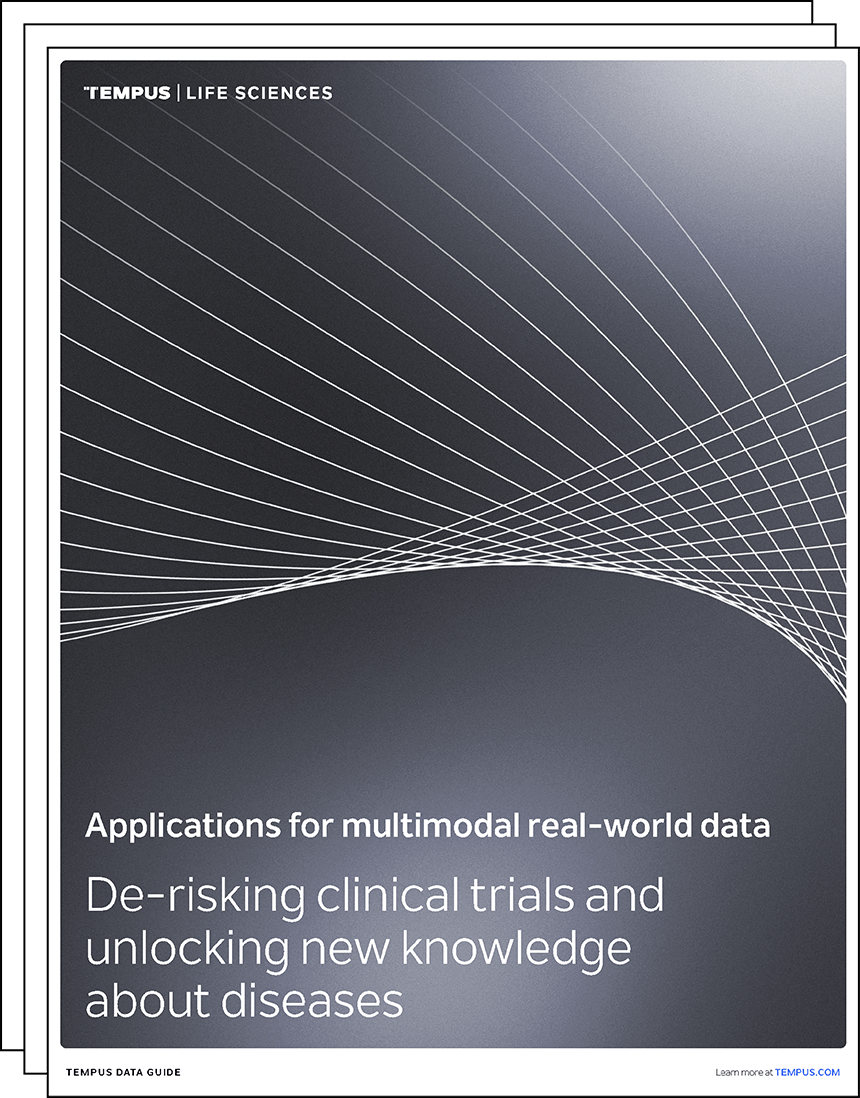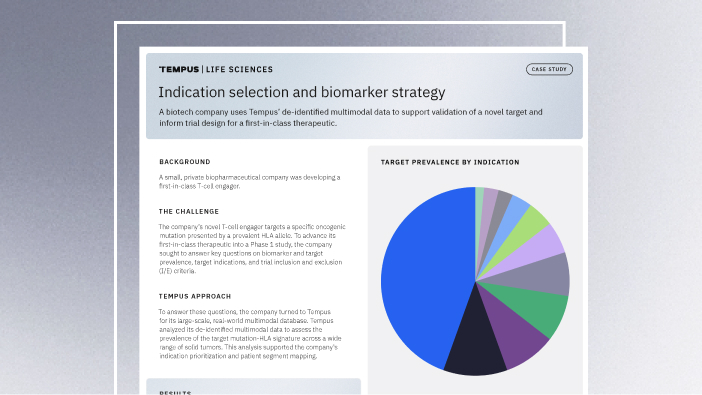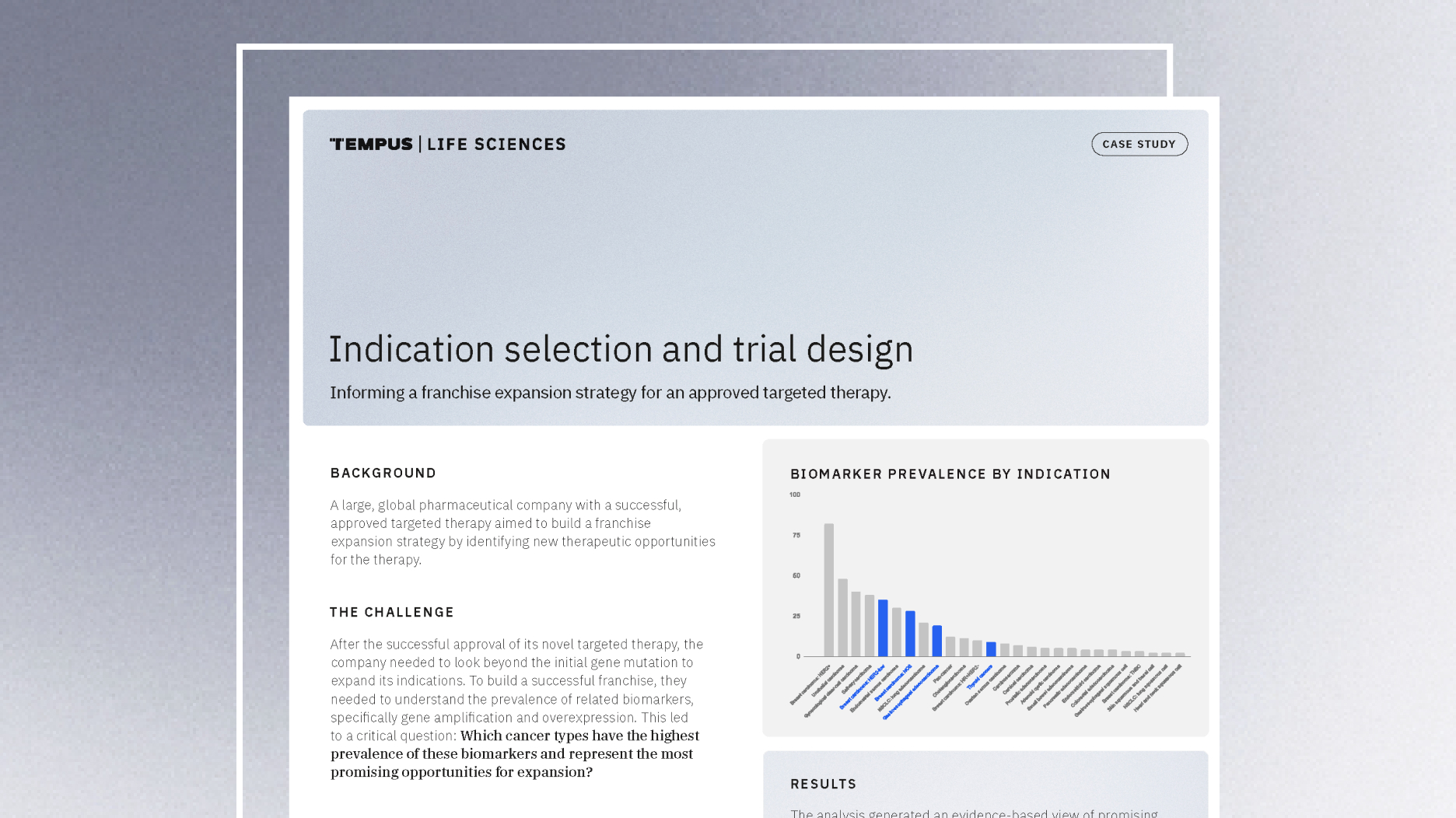-
PROVIDERS
New MRD Medicare Coverage for Select Indications*
*When coverage criteria are met. Additional criteria and exceptions for coverage may apply.
-
LIFE SCIENCES
ENROLL NOW
Tempus’ patient-derived organoid screens
Evaluate the efficacy of your preclinical compounds using fixed organoid panels designed for diverse therapeutic applications -
PATIENTS
It's About Time
View the Tempus vision.
- RESOURCES
-
ABOUT US
View Job Postings
We’re looking for people who can change the world.
- INVESTORS
02/27/2023
Leveraging Tempus AI and multimodal data to increase probability of technical success in Biopharma
Authors
Iker Huerga, SVP of Life Sciences Strategy
Advances in oncology treatments over the past 20 years have significantly extended patients’ life expectancy. From 2001 to 2020, cancer death rates dropped 27% [1]. However, there are still many unmet needs, which the life science community is working hard to address.
In 2020, the pharmaceutical industry spent $91 billion dollars in R&D across all diseases, up from $83 billion in 2019, and a record $102 billion in 2021 [2]. Adjusted for inflation, that amount is about 10 times what the industry spent per year in the 1980s [3] – reflecting the challenge and investment required to drive the next breakthroughs in some of the hardest-to-treat diseases.
With the expected cost to develop a single new molecular entity now between $1 billion and more than $2 billion [4], developing the new medicines that will help achieve the Cancer Moonshot goal of further reducing the death rate from cancer by 50% over the next 25 years [5] is a big challenge. It’s hard to imagine how the pharmaceutical industry could sustain the current growth rate in R&D, ensure medicines are affordable and still enable developers to bring more efficient and tolerable treatments to patients as quickly as possible.
Factors that determine whether a pharmaceutical company will invest in developing a new therapeutic are largely centered around three elements: the unmet need, expected lifetime global revenues of a new drug (to support a cycle of R&D reinvestment) and the likelihood that the development effort will succeed.
At Tempus, we’ve been working with our strategic collaborators, such as AstraZeneca [6], over the last few years to explore how the combination of AI and multimodal data can help with the third element – increasing the probability of success of their development programs, with the ultimate goal of creating efficiencies in the R&D process to bring new, effective medicines to patients faster.
Through this process, we co-designed with AstraZeneca the following three-step framework on how to systematically implement and quantify the benefits of deploying AI and multimodal data at scale to accelerate and de-risk key development programs.
1. Choose a metric that matters for the business and measure it
With so many AI-driven drug development projects failing to meet business goals, we decided early on that choosing the right metric (or KPI) to track was critical for the success of the program. We chose Probability of Technical Success (PTS) because it is a widely adopted metric by drug developers and investors alike
What is PTS
After a discovery, an investigational new drug has a certain probability of successfully going through all stages of development and ultimately being approved by health authorities like the FDA or EMA. This is called Probability of Technical and Regulatory Success (PTRS). PTRS is the product of Probability of Technical Success (PTS) and Probability of Regulatory Success (PRS). The technical part, PTS, can be simplified as the probability of choosing the right technical parameters that will provide a positive result in a clinical trial, like inclusion and exclusion criteria, stratification factors, endpoints, and other elements.
PTRS = PTS * PRS
At Tempus, our approach has been leveraging AI and multimodal data to increase PTS. This allows us to systematically track and report on the impact and value that the Tempus platform brings to the R&D process.
2. Start with a small pilot
Once we have the right value metric, the next step is to identify one to five clinical trials to launch a pilot program. We typically recommend our collaborators select the most suitable programs based on one of the following two use cases:
– Single-arm Phase 2 studies in which we create an external control arm to better contextualize the efficacy of the experimental treatment to inform a go/no-go Phase 3 decision.
– Registrational Phase 3 studies where we can increase PTS by better understanding and identifying the clinical and molecular determinants for selecting the optimal population.
The biggest value and acceleration come when we combine both by selecting a Phase 2 program to help make an informed go/no-go decision, and then quickly design the subsequent Phase 3. In all cases, Tempus provides its library of multimodal data (DNA and RNA molecular data, clinical data including outcomes, and imaging data) targeted to the needs of our collaborators, as well as the necessary staff to support the product teams analyzing the data to quickly make informed decisions.
Typically, the necessary multimodal data is already available in our library, which currently includes more than 6 million de-identified research records. In other scenarios, the data simply doesn’t exist and Tempus needs to leverage its unique network to source research specimens, sequence them, and pair the molecular data with the clinical data. In both scenarios, Tempus has the ability to utilize its unique platform and its suite of products and services to provision and generate the most suitable multimodal data assets for the programs in the pilot.
During the pilot, the Tempus team and the product teams work closely to assess PTS before and after our AI and multimodal data analysis. The difference between both, before and after, is what we call “PTS uplift” and will be tracked on a study per study basis, and ultimately reported as the total benefit of the pilot.
“During the pilot, we saw an average increase in PTS per study of 5 percentage points” – Cristian Massacesi, Chief Medical Officer and Oncology Chief Development Officer at AstraZeneca
3. Make it part of the governance process and scale the pilot
After seeing the value generated in the first 3-6 months through the pilot, most organizations will choose to implement this program as part of their governance process. This will ensure that all their programs can benefit from leveraging Tempus’ AI and multimodal data capabilities.
This typically means scaling up the initial pilot program to anywhere from 10-40 clinical trials a year, depending on the size of the overall portfolio of our collaborator. Together with resources within the collaborator, Tempus is uniquely positioned to enable the scaling of pilots due to the depth of the data science capabilities that deploy the AI solutions and its multimodal data that is broad enough to answer many questions.
This is the easiest step of all three. Once our partners see the value that combining AI with multimodal data at scale can bring to their programs, they rapidly want to implement it across their entire portfolio.
“After seeing the benefits of the pilot, we decided to make this approach part of our governance process. Today, our oncology Phase 3 study designs are informed by RWE dataset analyses combined with Tempus analysis. It’s become an integral part of our clinical trial design process.” – Cristian Massacesi, Chief Medical Office and Oncology Chief Development Officer at AstraZeneca
Citations
[1] An Update on Cancer Deaths in the United States. (2022, February 28). Centers for Disease Control and Prevention.
[2] Research and Development in the Pharmaceutical Industry. (2021, April 8). Congressional Budget Office.
[3] Pharmaceutical Research and Manufacturers of America. (2022). 2022 PhRMA Annual Membership Survey. phrma.org.
[4] The Journal of Health Care Organization, Provision, and Financing, Rennane, S., PhD, Baker, L., MSc, & Mulcahy, A., PhD. (n.d.). Estimating the Cost of Industry Investment in Drug Research and Development: A Review of Methods and Results.
[5] The White House. (2022, February 2). Fact Sheet: President Biden Reignites Cancer Moonshot to End Cancer as We Know It.
[6] Tempus. (2021, December 29). Tempus Signs Strategic Collaboration Agreement with AstraZeneca to Advance Oncology Therapeutics.
Learn more

Learn more
Applications for multimodal real-world data
De-risking clinical trials and unlocking new knowledge about diseases
DOWNLOAD GUIDEStay informed
Be notified whenever Tempus publishes new and relevant research, webinars, and other resources.
Sign up-
11/11/2025
A new era of biopharma R&D: The TechBio revolution—realities and the next frontier
Join Tempus and Recursion leaders to explore their strategic TechBio partnership. Learn how they use AI and supercomputing with petabytes of data to accelerate drug discovery and development. See the impact on biopharma R&D's future.
Watch replay -
11/14/2025
Validating a novel target and informing trial design for a first-in-class therapeutic
Discover how a biopharma company used Tempus’ de-identified multimodal data to support validation of a novel target and inform trial design for a first-in-class therapeutic.
Read more -
11/14/2025
Guiding indication expansion with multimodal real-world data
Discover how a biopharma company used Tempus’ multimodal real-world data to guide its indication expansion strategy. See how our analysis of biomarker prevalence helped them identify new opportunities, prioritize R&D, and inform future trial design.
Read more


